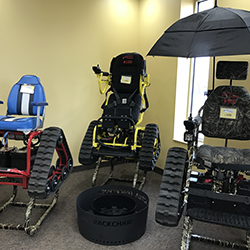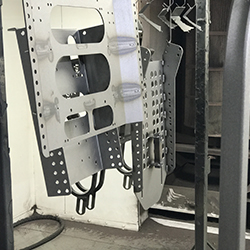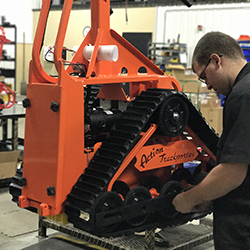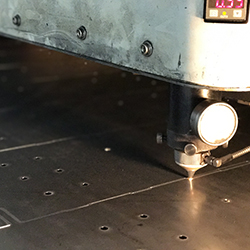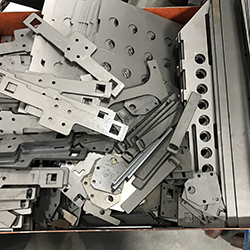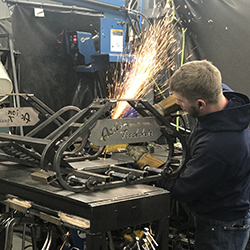Breaking New Ground
Action Manufacturing uses RADAN and Radbend to manufacture its custom line of Action Trackchairs.
Strolling along a sandy beach or through a sun-dappled forest are two of life’s simple pleasures that many of us take for granted.
For those confined to wheelchairs, spending time in nature — or even traversing a particularly uneven street — can be difficult or impossible to accomplish, especially without assistance.
That’s why Tim Swenson, owner of Action Manufacturing, decided to make a difference. After his then 16-year-old son, Jeff, was paralyzed in an accident in 1998, he took his son’s mobility challenges into his own hands by designing a chair that employs tracks instead of wheels to deliver the ultimate in transportation.
“When you have a family member in a wheelchair, you see a lot more wheelchairs,” says Swenson, who owned a motorsports retail business for 30 years. “After we sold the business to our other son, Jim, we decided that we had to start building something for Jeff because we wanted him to go out and be able to do the things that he did before the accident. He was a typically active boy, and what we came up with is a very unique product.”
For those confined to wheelchairs, spending time in nature — or even traversing a particularly uneven street — can be difficult or impossible to accomplish, especially without assistance.
That’s why Tim Swenson, owner of Action Manufacturing, decided to make a difference. After his then 16-year-old son, Jeff, was paralyzed in an accident in 1998, he took his son’s mobility challenges into his own hands by designing a chair that employs tracks instead of wheels to deliver the ultimate in transportation.
“When you have a family member in a wheelchair, you see a lot more wheelchairs,” says Swenson, who owned a motorsports retail business for 30 years. “After we sold the business to our other son, Jim, we decided that we had to start building something for Jeff because we wanted him to go out and be able to do the things that he did before the accident. He was a typically active boy, and what we came up with is a very unique product.”
That unique product was the prototype for Action Manufacturing’s Action Trackchair, an option virtually nonexistent until Swenson’s innovation was introduced to the market in 2009.“With the software and the laser, we can build much more accurately, and that has eliminated a massive amount of time and waste for prototyping and manufacturing.”
Darren Nelson, director of fabrication and research and
development
“There were a few people who made some one-off off-road wheelchairs, but nothing with any quantity,” he says. “We’re really the first ones in the world to produce a quantity of off-road wheelchairs. To go out in the woods and go hunting, or for a walk in the park, there was nothing.”
Swenson is quick to note that, while the Action Trackchair appeals to those who long for the recreational mobility that they once had or were never able to experience, the chair is also attractive to disabled farmers and others with occupations that demand some level of physicality.
The innovation is likewise a hit with small children, disabled veterans and amputees from all over the world. Swenson recently shipped a chair to a disabled girl in Kenya, who will drive it with her chin. Available in 16 different models, each chair is custom and made-to-order.
“We figure out what size you need, what colors you want, right or left controls, and there are many different accessories you can put on,” Swenson says.
To manufacture its range of custom-tracked machinery, Action Manufacturing has used the RADAN sheet-metal computer-aided-manufacturing (CAM) solution, by Vero Software, since January of 2016. Swenson was introduced to RADAN when he acquired a Mazak CO2 laser, which was equipped with the software.
To program parts in RADAN, Darren Nelson, director of fabrication and research and development for Action Manufacturing, creates solid models in the SOLIDWORKS® computer-aided-design (CAD) system, by Dassault Systèmes. The solid models are then seamlessly imported into RADAN, where CNC toolpath is applied.
The Action Manufacturing team is pleased to have a CAM system that pairs seamlessly with SOLIDWORKS, which was implemented in 2015.
Available in Radbend, a RADAN product for programming press brakes, is a SOLIDWORKS plugin that helps users streamline and maximize interoperability between the two solutions. The Radbend plug-in allows users to click on the Radbend icon within the SOLIDWORKS interface to easily transfer drawings and associated files into Radbend. “Radbend can import assemblies from SOLIDWORKS and prepare flat patterns that are ready for the laser,” Nelson says.
Nelson uses Radbend to program parts for the company’s press brake, which is not equipped with a CNC control. However, Action Manufacturing plans to install a CNC press brake, as well as another CNC laser, as part of its ongoing expansion.
Nelson credits RADAN and Radbend for helping the shop to boost overall efficiency and accuracy while reducing scrap. The shop plans to eliminate paper on the shop floor, which today is used by operators following bending programs output by Radbend.
“The operator will just look at the control to see what next step is,” Nelson explains. “They’ll be able to just take the part off laser and take it over to the press brake.”
The implementation of RADAN has cemented the company’s ability to manufacture precision parts with extremely tight tolerances for the ultimate in performance.
“We program the holes so tight that they’re oversized for the paint and the primer, with just enough room so that the paint won’t crack when we put it all together,” Nelson says. “All of the holes that we used to drill are cut with a laser and we only use a tape measure one time when we’re programming the chair. It makes it almost idiot proof.”
“Idiot proof” manufacturing, which includes a reduction in handling and increase in overall flexibility, reduces stress when it comes to day-to-day processes and makes programming “oddball parts” simpler than ever before.
“With the software and the laser, we can build much more accurately, and that has eliminated a massive amount of time and waste for prototyping and manufacturing,” Nelson says.
“Before RADAN, I’d lay it all out by hand, drill the holes, then take it to the press brake. With the laser, everything is perfect unless you program it wrong — and if you program it wrong, you can easily fix it. If you have some oddball part, you can have it made in 15 minutes.”
Designed initially to help one young man experience life to the fullest, the Action Trackchair has paved the way for further innovation from Action Manufacturing. The company’s expanding product line also includes an ActionTrack porter, for transporting deceased livestock, and a line of robots.
The company has also added 12,000 square feet of building space, which will be greatly needed as it continues to expand its line of products and the machinery needed to make them.
“When we started building track chairs, it was a family need that turned into more items and, as we begin to offer more items, we need more and different equipment,” Nelson says. “We really can’t have one without the other.”
About the Company
Name: Action Manufacturing
Business: Manufacturing of custom chairs equipped with tracks for greater “wheelchair” mobility
Web: actiontrackchair.com
Benefits Achieved
- Boost in overall efficiency
- Reduction of human error and scrap material
- Ability to more easily manufacture high-precision parts with tight tolerances
Comments
“With the software and the laser, we can build much more accurately, and that has eliminated a massive amount of time and waste for prototyping and manufacturing.”
Darren Nelson, director of fabrication and research and development









